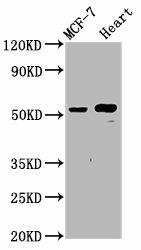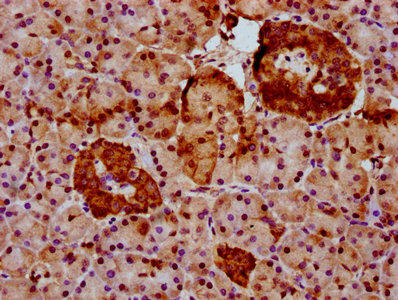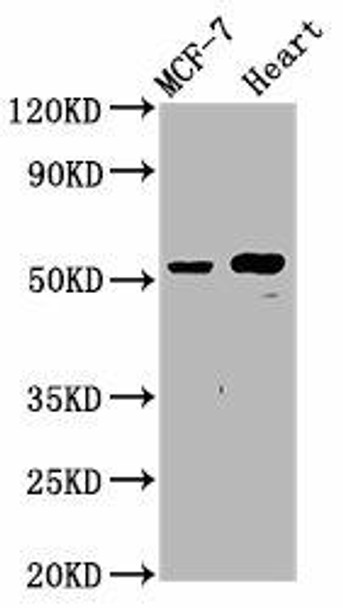Description
| Antibody Name: | NOP53 Antibody (PACO59493) |
| Antibody SKU: | PACO59493 |
| Size: | 50ug |
| Host Species: | Rabbit |
| Tested Applications: | ELISA, WB, IHC |
| Recommended Dilutions: | ELISA:1:2000-1:10000, WB:1:500-1:5000, IHC:1:500-1:1000 |
| Species Reactivity: | Human, Rat |
| Immunogen: | Recombinant Human Ribosome biogenesis protein NOP53 protein (227-405AA) |
| Form: | Liquid |
| Storage Buffer: | Preservative: 0.03% Proclin 300 Constituents: 50% Glycerol, 0.01M PBS, pH 7.4 |
| Purification Method: | >95%, Protein G purified |
| Clonality: | Polyclonal |
| Isotype: | IgG |
| Conjugate: | Non-conjugated |
 | Western Blot. Positive WB detected in: MCF-7 whole cell lysate, Rat heart tissue. All lanes: NOP53 antibody at 4.8µg/ml. Secondary. Goat polyclonal to rabbit IgG at 1/50000 dilution. Predicted band size: 55 kDa. Observed band size: 55 kDa. |
 | IHC image of PACO59493 diluted at 1:600 and staining in paraffin-embedded human pancreatic tissue performed on a Leica BondTM system. After dewaxing and hydration, antigen retrieval was mediated by high pressure in a citrate buffer (pH 6.0). Section was blocked with 10% normal goat serum 30min at RT. Then primary antibody (1% BSA) was incubated at 4°C overnight. The primary is detected by a biotinylated secondary antibody and visualized using an HRP conjugated SP system. |
| Background: | Nucleolar protein which is involved in the integration of the 5S RNP into the ribosomal large subunit during ribosome biogenesis. In ribosome biogenesis, may also play a role in rRNA transcription. Also functions as a nucleolar sensor that regulates the activation of p53/TP53 in response to ribosome biogenesis perturbation, DNA damage and other stress conditions. DNA damage or perturbation of ribosome biogenesis disrupt the interaction between NOP53 and RPL11 allowing RPL11 transport to the nucleoplasm where it can inhibit MDM2 and allow p53/TP53 activation. It may also positively regulate the function of p53/TP53 in cell cycle arrest and apoptosis through direct interaction, preventing its MDM2-dependent ubiquitin-mediated proteasomal degradation. Originally identified as a tumor suppressor, it may also play a role in cell proliferation and apoptosis by positively regulating the stability of PTEN, thereby antagonizing the PI3K-AKT/PKB signaling pathway. May also inhibit cell proliferation and increase apoptosis through its interaction with NF2. May negatively regulate NPM1 by regulating its nucleoplasmic localization, oligomerization and ubiquitin-mediated proteasomal degradation. Thereby, may prevent NPM1 interaction with MYC and negatively regulate transcription mediated by the MYC-NPM1 complex. May also regulate cellular aerobic respiration. In the cellular response to viral infection, may play a role in the attenuation of interferon-β through the inhibition of DDX58/RIG-1. |
| Synonyms: | Ribosome biogenesis protein NOP53 (Glioma tumor suppressor candidate region gene 2 protein) (Protein interacting with carboxyl terminus 1) (PICT-1) (p60), NOP53, GLT GLTSCR2 PICT1 |
| UniProt Protein Function: | GLTSCR2: Belongs to the GLTSCR2 family.Protein type: NucleolusChromosomal Location of Human Ortholog: 19q13.3Cellular Component: intracellular membrane-bound organelle; nucleolus |
| UniProt Protein Details: | |
| NCBI Summary: | |
| UniProt Code: | Q9NZM5 |
| NCBI GenInfo Identifier: | 93141272 |
| NCBI Gene ID: | 29997 |
| NCBI Accession: | Q9NZM5.2 |
| UniProt Secondary Accession: | Q9NZM5,Q9BTC6, Q9HAX6, Q9NPP1, Q9NPR4, Q9UFI2 |
| UniProt Related Accession: | Q9NZM5 |
| Molecular Weight: | 54,389 Da |
| NCBI Full Name: | Glioma tumor suppressor candidate region gene 2 protein |
| NCBI Synonym Full Names: | glioma tumor suppressor candidate region gene 2 |
| NCBI Official Symbol: | GLTSCR2 |
| NCBI Official Synonym Symbols: | PICT1; PICT-1 |
| NCBI Protein Information: | glioma tumor suppressor candidate region gene 2 protein |
| UniProt Protein Name: | Glioma tumor suppressor candidate region gene 2 protein |
| UniProt Synonym Protein Names: | p60 |
| Protein Family: | Glioma tumor suppressor candidate region gene 2 protein |
| UniProt Gene Name: | GLTSCR2 |
| UniProt Entry Name: | GSCR2_HUMAN |






